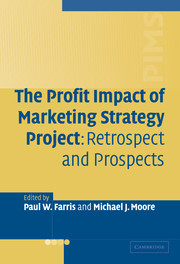Book contents
- Frontmatter
- Contents
- List of figures
- List of tables
- Notes on contributors
- Acknowledgments
- Introduction
- 1 The PIMS project: vision, achievements, and scope of the data
- 2 Putting PIMS into perspective: enduring contributions to strategic questions
- 3 PIMS and COMPUSTAT data: different horses for the same course?
- 4 Order of market entry: empirical results from the PIMS data and future research topics
- 5 Does innovativeness enhance new product success? Insights from a meta-analysis of the evidence
- 6 Marketing costs and prices: an expanded view
- 7 The model by Phillips, Chang, and Buzzell revisited – the effects of unobservable variables
- 8 Causation and components in market share–performance models: the role of identities
- 9 Cargo cult econometrics: specification testing in simultaneous equation marketing models
- 10 PIMS and the market share effect: biased evidence versus fuzzy evidence
- 11 PIMS in the new millennium: how PIMS might be different tomorrow
- Select bibliography
- Author index
- Subject index
- References
10 - PIMS and the market share effect: biased evidence versus fuzzy evidence
Published online by Cambridge University Press: 22 September 2009
- Frontmatter
- Contents
- List of figures
- List of tables
- Notes on contributors
- Acknowledgments
- Introduction
- 1 The PIMS project: vision, achievements, and scope of the data
- 2 Putting PIMS into perspective: enduring contributions to strategic questions
- 3 PIMS and COMPUSTAT data: different horses for the same course?
- 4 Order of market entry: empirical results from the PIMS data and future research topics
- 5 Does innovativeness enhance new product success? Insights from a meta-analysis of the evidence
- 6 Marketing costs and prices: an expanded view
- 7 The model by Phillips, Chang, and Buzzell revisited – the effects of unobservable variables
- 8 Causation and components in market share–performance models: the role of identities
- 9 Cargo cult econometrics: specification testing in simultaneous equation marketing models
- 10 PIMS and the market share effect: biased evidence versus fuzzy evidence
- 11 PIMS in the new millennium: how PIMS might be different tomorrow
- Select bibliography
- Author index
- Subject index
- References
Summary
Simple econometric models often produce results that may be interpreted in different ways. In response to disagreements over how to interpret such models, researchers have begun to apply increasingly sophisticated econometric models and estimation techniques. However, it is not always clear that available data are appropriate for the task presented by the more sophisticated models. In this chapter we address such a problem.
The controversy
One of the key early findings from the PIMS database was the positive effect of market share on business profitability (Buzzell and Gale 1987; Buzzell, Gale, and Sultan 1975). The argument was that higher market share yielded advantages in efficiency and thus resulted in lower average cost. Based on the empirical evidence from PIMS and other studies, such as those with the Federal Trade Commission's Line of Business database (e.g. Ravenscraft 1983), Scherer et al. (1987) contended that the market share effect is “robust,” and a number of analysts and consultants promoted the unbeatable logic of market share building strategies (e.g. Henderson 1979).
However, a number of researchers raised serious questions about the validity of the market share effect. Some pointed out that the observed regularity lacked a theoretical base (e.g. Rumelt and Wensley 1980). In fact, knowledge of such a strategic relationship would force all firms to compete more forcefully for market share, which would eliminate the returns implied by the relationship, unless “isolating mechanisms” existed that limited competition (Wensley 1982).
- Type
- Chapter
- Information
- The Profit Impact of Marketing Strategy ProjectRetrospect and Prospects, pp. 260 - 271Publisher: Cambridge University PressPrint publication year: 2004

